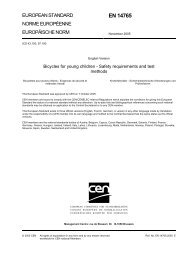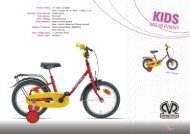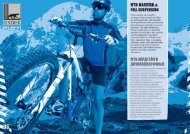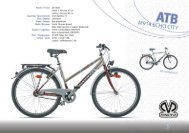EN 14766:2005 - 64_e_stf - Baltik vairas
EN 14766:2005 - 64_e_stf - Baltik vairas
EN 14766:2005 - 64_e_stf - Baltik vairas
- No tags were found...
Create successful ePaper yourself
Turn your PDF publications into a flip-book with our unique Google optimized e-Paper software.
<strong>EN</strong> <strong>14766</strong>:<strong>2005</strong> (E)4.6.7.5.2.6 Vertical force on the test wheelThe wheel to be tested shall be forced vertically downwards so that no skidding of the wheel occurs when testedaccording to 4.6.7.5.2.7 III) a) and b).NOTE The necessary force may be applied anywhere on the bicycle (wheel-axle, bottom bracket, seat-post etc.) providedthat it is exerted vertically downwards.4.6.7.5.2.7 Test methodI) GeneralTest the front and rear wheels individually.II)Running-in the braking surfacesConduct a running-in process on every brake before carrying out the performance test.In order to determine the operating force to be used during the running-in process, mount and load the bicycle onthe test machine with the belt or drum running at the specified speed and apply an operating force to thehandbrake lever that is high enough to achieve a braking force of 200 N ± 10 %. Maintain this operating force for atleast 2,5 s, and note the value of the applied operating force.Repeat the procedure (applying the operating force determined as above accurate to within ± 5 %) ten times, or,with more repetitions if necessary, until the mean braking force from anyone of the three latest tests does notdeviate by more than ± 10 % from the mean braking force from these same three tests.III) The performance testsa) Testing under dry conditionsWith a vertical force applied to the bicycle sufficient to prevent skidding of the tyre on the wheel under test,accelerate the driving mechanism to the specified velocity, then apply the operating-force in a series of 20 Nincrements from 40 N to either 180 N or to the force necessary to achieve a braking force of at least 700 N,whichever is the lesser. However, if the wheel locks, if any possible brake-overload device is actuated, or if thehand-lever comes into contact with the handlebar, do not increase the force further. For each increment of appliedoperating force, perform three tests within 1 min. Before applying the next level of operating force, allow the braketo cool for 1 min.The applied operating forces shall lie within ± 10 % of the intended operating forces, shall be applied as specified in4.6.2.2.3 and 4.6.7.5.2.4 c), shall be recorded with an accuracy of ± 1 %, and shall be fully applied within 1 s of thecommencement of braking.For each increment of hand-lever force, record the braking force value, F Br rec , for a period of between 2,0 s and2,5 s, with measurement starting 0,5 s to 1,0 s after the commencement of braking (see 3.11). Record F Br rec as theaverage braking force during this measurement period.The time at which the measurement of the braking force is started shall be related to the speed at which theoperating force is applied. If the operating force is fully applied in less than 0,5 s after the commencement ofbraking, start the measurement after 0,5 s. However, if the operating force is fully applied between 0,5 s and 1,0 safter the commencement of braking, start the measurement when the operating force is fully applied.b) Testing under wet conditionsThe method shall be as given in 4.6.7.5.2.8 III) a) with the addition that wetting of the brake system shallcommence not less than 5 s before the commencement of braking for each increment of operating force and shallcontinue until the measurement period has ended.Water nozzles shall be arranged according to Figure 16.31







